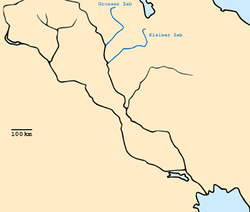This article has multiple issues. Please help improve it or discuss these issues on the talk page. (Learn how and when to remove these messages)
|
| Battle of the Zab | |||||||||
|---|---|---|---|---|---|---|---|---|---|
| Part of the Abbasid Revolution | |||||||||
 Greater Zab River Map in Iraq | |||||||||
| |||||||||
| Belligerents | |||||||||
|
|
| ||||||||
| Commanders and leaders | |||||||||
|
Abu Muslim[1] Saffah[2] Abd Allah ibn Ali[3][4] Abu Awn | Marwan II (WIA)[citation needed] | ||||||||
| Strength | |||||||||
| Around 40,000[citation needed] | Around 100,000[5] | ||||||||
The Battle of the Zab (Arabic: معركة الزاب), also referred to in scholarly contexts as Battle of the Great Zāb River, took place on January 25, 750, on the banks of the Great Zab[6] in what is now the modern country of Iraq. It spelled the end of the Umayyad Caliphate and the rise of the Abbasid Caliphate, which would last from 750 to 1517.
- ^ For a source confirming Abu Muslim as a leader in the battle, see EUF Staff (2019). "'Abbāsides: La révolution 'abbāside". Encyclopædia Universalis (in French). Hervé Rouanet, Directeur général (online ed.). Boulogne-Billancourt, France: Encyclopædia Universalis France (EUF), for Encyclopedia Britannica. Retrieved 17 December 2019.
Abū Muslim déclencha l'opération en 747 et la victoire fut acquise à la bataille du Grand Zāb en 750. Ibrāhīm étant mort entre-temps, Abū Muslim proclama calife son frère Abū l-'Abbās, dit as-Saffāḥ, en 749 à Kūfa. Abū Muslim started the operation in 747 and victory was gained at the Battle of the Great Zāb in 750. Ibrāhīm having died in the meantime, Abū Muslim proclaimed [as] caliph his brother Abū l-'Abbās, known as as-Saffāḥ, in 749 in Kūfa.
- ^ Kennedy, H. (2004). The prophet and the age of the caliphates. 2nd ed.
- ^ Zetterstéen 1987, pp. 22–23.
- ^ Grohmann & Kennedy 1995, p. 985.
- ^ Ibn Kathir Al-Bidāya wa-n-Nihāya (The Beginning and The End)
- ^ Sharon, Moshe (1983). Black Banners from the East: The Establishment of the ʻAbbāsid State : Incubation of a Revolt. JSAI. p. 13. ISBN 978-965-223-501-5.